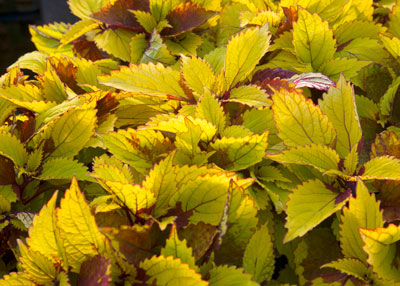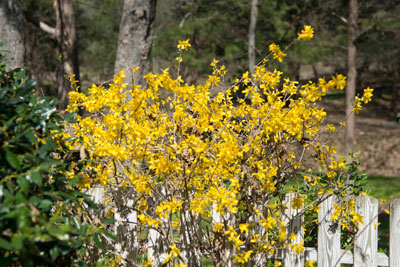When Yellow Ain’t Mellow!
We have lots of great choices when it comes to yellow plants. I’ve brought with me three of my all-time favorites, and I’ll tell you why. Odd stories, each of them.

Coleus ‘Pineapple’ was one of those fabulous selections in the Texas A&M greenhouses when I was a kid growing up in College Station. However, the prof in charge of the plants turned me down when I asked for cuttings.
But my luck turned. I saw the plants in the trashcans one evening and I grabbed some and took them home to my greenhouse. I grew them in our own yard, and when I transferred to Ohio State as a junior I took them with me. I grew large plants in baskets to decorate my in-laws’ yard the day Lynn and I married.
So ‘Pineapple’ and I go back many years, and it will be in our yard again this year. Lots of other coleus varieties have come along in the past 20 years, but this one still holds a special spot in my heart, and now you know why.
‘Pineapple’ does best in morning sun with afternoon shade. It is reluctant to bloom if you keep it growing vigorously. That’s a good thing, since floral stalks shut down the production of new leaves. It’s also outstanding in large, decorative pots.

Forsythia
We Texans don’t have a lot of yellow-flowering shrubs for the spring. This one, best adapted to the north and east sections of the state, is outstanding. We have 8 or 10 of them in our rural Collin County landscape. They’ve been in place for 20 to 30 years and every spring, just as the daffodils start to fade, they begin to kick in. This photo is outside my office window at home, taken just a couple of days ago.
When I was in graduate school at Ohio State I needed a shrub that would grow quickly and that was really dependable for my research. I chose forsythia. We were trying it in snow bank plantings along I-71 north of Columbus, so we had a good reason to use it. I raised several hundred under various growing regimes, then I spent some really cold evenings washing soil from their roots out behind the horticulture greenhouses. Those were long days and nights, but in retrospect, they were great times, so the memories are fond.

Carolina jessamine also strikes an emotional chord. I was paid fairly well as an Extension employee back in the mid-70s, but when it came time to have our second baby, funds just weren’t readily available. I decided to raise Carolina jessamines in 1-gallon containers to pay in part for Todd’s birth.
As for its particulars, here’s what I posted on Facebook just a few days ago… (Photo from five days ago in Collin County – I realize they may have finished blooming in South Texas.)
“Garden Tip: I’m frequently asked to recommend a flowering evergreen vine that will remain mannerly and bloom in the shade. If it weren’t for this plant, I’d probably exclaim “Yikes! That’s about three restrictions too many.”
“But thank heavens for Carolina jessamine (note the spelling – it’s not “jasmine”). Gelsemium sempervirens. Native from East Texas clear to the East Coast. And as good as it is in the shade, it’s even better in the sun.
“It climbs by twining (as opposed to tendrils or holdfasts), so it’s great for wood or wrought iron fences. And best of all, it has wonderful fragrance while it blooms for a couple of weeks this time of year.
“It does best in highly organic, moist soils. You’ll see its leaves fading to yellowish green if it needs iron and nitrogen. If it gets top-heavy after 8 or 10 years, trim it back right after it blooms and apply an all-nitrogen plant food to encourage vigorous regrowth.”
